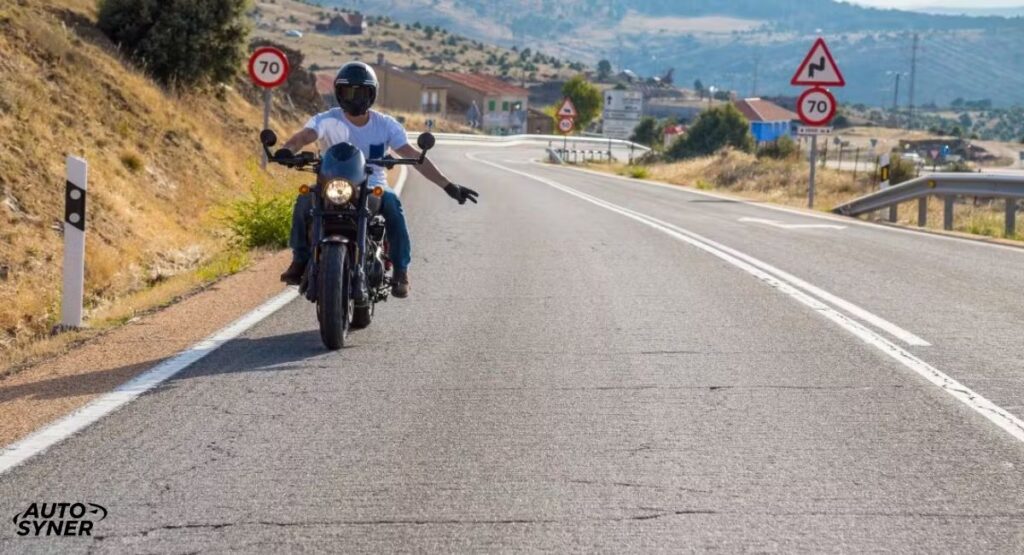Motorcycle hand signals are crucial for safe riding. They help communicate your intentions to other drivers. Knowing these signals can prevent accidents and keep you safe on the road. This guide will cover the essential hand signals every rider should use. Being familiar with them is vital for any motorcycle enthusiast.
Before hitting the road ensure you understand these basic signals. They are a key part of motorcycle safety and etiquette. Proper use of hand signals helps in clear communication with fellow riders and drivers. Mastering these signals will improve your riding experience. Stay informed and ride safely with these essential hand signals.
What Are Motorcycle Hand Signals and Why Are They Important?
What Are Motorcycle Hand Signals?
- Definition: Motorcycle hand signals are specific gestures made by riders to convey their intentions to other road users.
- Common Signals: These include signals for turning left or right stopping, and slowing down.
- Standardization: Hand signals are standardized to ensure consistency and clarity among riders.
Why Are Hand Signals Important?
- Enhanced Safety: Hand signals help prevent accidents by making your actions clear to other drivers.
- Clear Communication: They provide a universal way to communicate intentions when riding.
- Legal Requirements: In many areas using hand signals is legally required to ensure road safety.
- Improved Riding Experience: Proper signals contribute to smoother and more predictable riding.
- Emergency Situations: In case of signal failure or visibility issues hand signals can be a reliable backup.
The Essential Motorcycle Hand Signals Every Rider Should Know
Every rider should know basic motorcycle hand signals for safety. These include signals for turning, stopping and slowing down. Mastering these helps communicate your intentions clearly on the road.
Left Turn
- Signal: Extend your left arm straight out to the side.
- Purpose: This signal indicates that you are making a left turn.
- Visibility: Ensure your arm is fully extended for maximum visibility to other drivers.
Right Turn
- Signal: Bend your left arm at a 90-degree angle, pointing upward.
- Purpose: This gesture shows that you are preparing to turn right.
- Alternative: Some riders also use their right arm to signal a right turn, extending it to the side.
Stop
- Signal: Bend your left arm at a 90-degree angle, with the hand pointing downward.
- Purpose: This indicates that you are stopping or slowing down.
- Visibility: Keep your arm steady to clearly signal your intention to other road users.
Slow Down
- Signal: Extend your left arm with the hand open, palm facing backward.
- Purpose: This signal informs others that you are slowing down.
- Usage: Use this signal well in advance of reducing speed to alert drivers behind you.
Hazard Warning
- Signal: Flash your left hand up and down or use your hazard lights if available.
- Purpose: This warns other riders and drivers of potential hazards ahead.
- Usage: Use this signal in emergency situations or when encountering obstacles.
Read This Blog: Where Is the VIN Number on a Car?
How to Properly Execute Motorcycle Hand Signals
To properly execute motorcycle hand signals extend your left arm fully. For a left turn keep your arm straight out. For a right turn bend your arm upward at a 90-degree angle. To signal a stop keep your arm down and palm open. Always make sure signals are clear and visible.
Practice these signals regularly to ensure they are second nature. Make sure your arm movements are smooth and deliberate. Check your mirrors and surroundings before signaling. Use hand signals consistently even in daylight or clear conditions. Proper execution enhances your safety and communication on the road.
Common Mistakes Riders Make with Hand Signals
Not Using Hand Signals Often Enough
- Some riders forget to use hand signals regularly.
- This can confuse other drivers.
- Make it a habit to signal all the time.
Making Signals Too Late or Too Early
- Signaling at the wrong time can mislead others.
- This timing mistake can cause safety issues.
- Signal at the right moment, before making a move.
Using Incorrect Hand Signals
- Incorrect signals can lead to misunderstandings.
- Using the wrong signal can be dangerous.
- Learn and use the correct signals for each action.
Not Extending the Arm Fully
- Not fully extending your arm makes signals less visible.
- This can prevent other drivers from seeing your signal.
- Extend your arm completely to ensure visibility.
Forgetting to Cancel Signals
- Forgetting to cancel signals can mislead other drivers.
- It may seem like you are still making a turn or lane change.
- Cancel your signals as soon as the maneuver is complete.
Motorcycle Hand Signals for Group Riding: Staying Safe Together
In group riding hand signals help maintain safety and coordination. Riders use signals to communicate turns stops and hazards to the entire group. Clear hand signals ensure everyone stays aware and safe throughout the ride.
Clear Communication in Group Rides
- Use hand signals to keep everyone informed.
- Ensure all riders understand the signals.
- This helps avoid confusion and accidents.
Signal Consistency Among Riders
- Agree on signals before the ride begins.
- Use the same signals throughout the ride.
- Consistent signals help everyone stay coordinated.
Legal Requirements for Motorcycle Hand Signals in Different States
Legal requirements for motorcycle hand signals vary by state. Some states mandate specific hand signals for turns and stops. Others may have different rules or not require signals at all. It is important to know your state regulations to avoid fines. Always check local laws to ensure compliance with hand signal rules.
State-Specific Motorcycle Hand Signal Laws
State-specific motorcycle hand signal laws can vary widely. Some states have strict rules on using hand signals for turns and stops. Others may only require signals under certain conditions or not at all.
It is important to familiarize yourself with the regulations in your state. Check local laws to ensure you are compliant. Knowing the rules will help you stay safe and avoid penalties.
Compliance Tips for Hand Signal Regulations
To comply with hand signal regulations always use clear and consistent signals. Check your local laws to understand the requirements. Regular practice will help you signal correctly and avoid penalties.
Understand Local Laws
- Research your state hand signal regulations.
- Check for any unique or updated requirements.
Practice Consistently
- Regularly practice clear and visible signals.
- Make hand signals a routine part of your riding.
Use Hand Signals Properly
- Extend your arm fully and signal at the right time.
- Ensure signals are easily seen by others.
Stay Informed
- Keep up with any changes in hand signal laws.
- Review regulations periodically and attend safety workshops.
Follow Legal Requirements
- Ensure all signals meet state laws.
- Avoid fines by using correct and timely signals.
When and Why to Use Motorcycle Hand Signals While Riding
Use motorcycle hand signals when turning stopping or changing lanes. These signals help other drivers understand your intentions. They improve safety by making your actions clear to everyone on the road.
When to Use Hand Signals
- Use signals when turning stopping, or changing lanes.
- Signal well in advance to inform other drivers of your intentions.
- Always signal even in clear weather and good visibility.
Why Hand Signals Are Important
- They help prevent accidents by providing clear communication.
- Consistent signaling maintains safety and shows responsible riding.
- Hand signals ensure that other drivers understand your movements.
Frequently Asked Question
What are motorcycle hand signals?
Motorcycle hand signals are gestures used by riders to communicate with other drivers. They indicate turns stops and lane changes. These signals help keep riding safe and clear.
Why are hand signals important for motorcycle riders?
Hand signals are crucial for safety as they inform other drivers of your intentions. They help prevent accidents by ensuring clear communication. Using hand signals can improve overall road safety.
How should I properly execute a motorcycle hand signal?
Extend your left arm fully for signals. Use a straight arm for left turns, a bent arm for right turns and a downward arm for stopping. Make sure your signals are clear and visible.
Are motorcycle hand signals required by law?
Yes many states require hand signals for motorcycle riders. The specific laws can vary by state. Check local regulations to ensure you are following the legal requirements.
What are common mistakes with motorcycle hand signals?
Common mistakes include not using signals regularly, signaling at the wrong time and not fully extending your arm. Avoid these errors to improve safety and communication while riding.
Conclusion
Motorcycle hand signals are essential for safe riding. They help communicate your intentions to other drivers and prevent accidents. Knowing and using these signals correctly can make your rides smoother and safer. Always remember to use clear and consistent signals whether you are turning stopping, or changing lanes.
By mastering these hand signals you ensure better communication with other road users. This practice not only keeps you and others safe but also helps you stay compliant with the law. Regularly review and practice your hand signals to make them a natural part of your riding routine. Staying informed and prepared is key to a safer riding experience.







